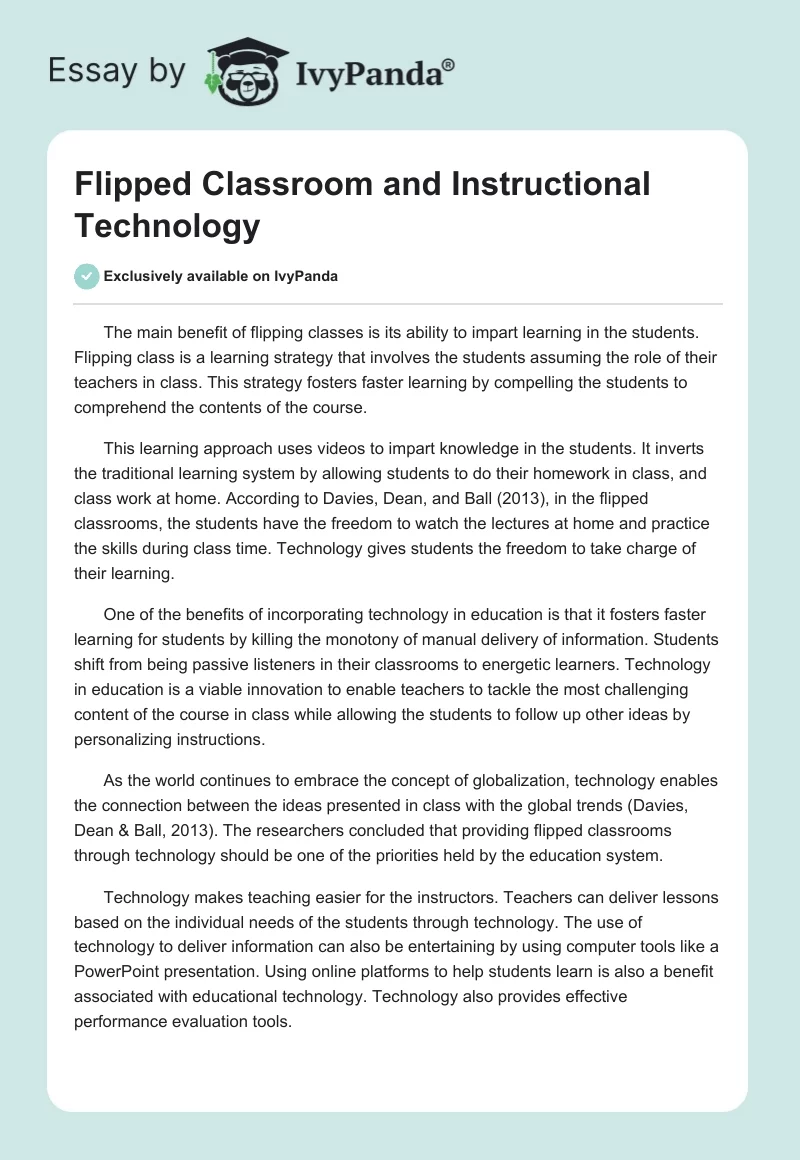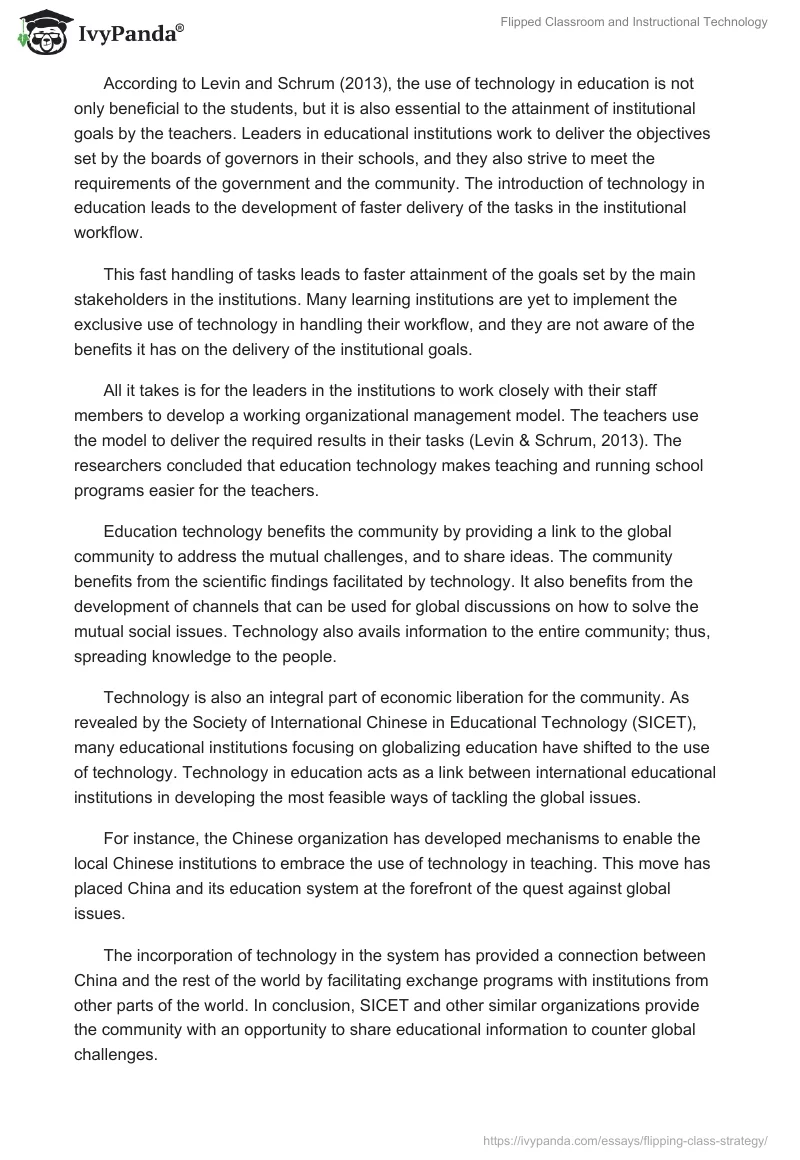The main benefit of flipping classes is its ability to impart learning in the students. Flipping class is a learning strategy that involves the students assuming the role of their teachers in class. This strategy fosters faster learning by compelling the students to comprehend the contents of the course.
This learning approach uses videos to impart knowledge in the students. It inverts the traditional learning system by allowing students to do their homework in class, and class work at home. According to Davies, Dean, and Ball (2013), in the flipped classrooms, the students have the freedom to watch the lectures at home and practice the skills during class time. Technology gives students the freedom to take charge of their learning.
One of the benefits of incorporating technology in education is that it fosters faster learning for students by killing the monotony of manual delivery of information. Students shift from being passive listeners in their classrooms to energetic learners. Technology in education is a viable innovation to enable teachers to tackle the most challenging content of the course in class while allowing the students to follow up other ideas by personalizing instructions.
As the world continues to embrace the concept of globalization, technology enables the connection between the ideas presented in class with the global trends (Davies, Dean & Ball, 2013). The researchers concluded that providing flipped classrooms through technology should be one of the priorities held by the education system.
Technology makes teaching easier for the instructors. Teachers can deliver lessons based on the individual needs of the students through technology. The use of technology to deliver information can also be entertaining by using computer tools like a PowerPoint presentation. Using online platforms to help students learn is also a benefit associated with educational technology. Technology also provides effective performance evaluation tools.
According to Levin and Schrum (2013), the use of technology in education is not only beneficial to the students, but it is also essential to the attainment of institutional goals by the teachers. Leaders in educational institutions work to deliver the objectives set by the boards of governors in their schools, and they also strive to meet the requirements of the government and the community. The introduction of technology in education leads to the development of faster delivery of the tasks in the institutional workflow.
This fast handling of tasks leads to faster attainment of the goals set by the main stakeholders in the institutions. Many learning institutions are yet to implement the exclusive use of technology in handling their workflow, and they are not aware of the benefits it has on the delivery of the institutional goals.
All it takes is for the leaders in the institutions to work closely with their staff members to develop a working organizational management model. The teachers use the model to deliver the required results in their tasks (Levin & Schrum, 2013). The researchers concluded that education technology makes teaching and running school programs easier for the teachers.
Education technology benefits the community by providing a link to the global community to address the mutual challenges, and to share ideas. The community benefits from the scientific findings facilitated by technology. It also benefits from the development of channels that can be used for global discussions on how to solve the mutual social issues. Technology also avails information to the entire community; thus, spreading knowledge to the people.
Technology is also an integral part of economic liberation for the community. As revealed by the Society of International Chinese in Educational Technology (SICET), many educational institutions focusing on globalizing education have shifted to the use of technology. Technology in education acts as a link between international educational institutions in developing the most feasible ways of tackling the global issues.
For instance, the Chinese organization has developed mechanisms to enable the local Chinese institutions to embrace the use of technology in teaching. This move has placed China and its education system at the forefront of the quest against global issues.
The incorporation of technology in the system has provided a connection between China and the rest of the world by facilitating exchange programs with institutions from other parts of the world. In conclusion, SICET and other similar organizations provide the community with an opportunity to share educational information to counter global challenges.
Education technology is very expensive, and it does not always result in faster programs. The investment placed in technology does not necessarily result in better learning programs. The constant growth in technology also means that institutions will have to keep changing their operating models.
These changes will pose challenges in teaching efficiency for the teachers in the future. The cost of installation of the newest technology will always be too high for educational institutions. According to Ping Lim, Yong, Tondeur, Ching Sing, and Chin-Chung (2013), not all schools that apply technology in education achieve the benefit of faster programs. While the advocacy for the implementation of technology in education is widespread, there are some limitations associated with this approach.
First, the initial cost of installation of the required hardware and software is quite expensive. While the use of technology in other industries translates in a reduction in the cost of some business processes, the use of technology in education increases the cost of operations.
Second, the implementation of technology in education poses a big challenge to the leaders and teachers in learning institutions because there are no clear guidelines developed to steer the effective implementation of this teaching approach. Most institutions still prefer using the traditional teaching approaches because they offer concise guidelines for teaching (Ching Sing, Yong, Tondeur, Ping & Ching-Chung, 2013).
The researchers concluded that using technology in education increases the cost of education through the required installation capital, the cost of maintenance and the cost of training to acquaint the teachers with the required skills.
In conclusion, the use of technology in teaching is an innovative approach to enhancing the effectiveness of teaching. It enables the application of a global outlook in the teaching process, and it makes the delivery of the institutional goals easier. The relevant authorities must develop the appropriate models to implement technology learning platforms in the education system. The use of technology in learning dictates that schools invest to facilitate the same.
This cost is always bound to increase the cost of education. The cost of implementation is high, but it can be met by the government in partnership with promoters from the private sector. The education systems in different nations are charged with the development of solutions to the global issues; hence, the use of technology in teaching has the potential to develop professionals with the capabilities to solve the issues.
References
Ching Sing, C., Yong, Z., Tondeur, J., Ping Lim, C., & Chin-Chung, T. (2013). Bridging the Gap: Technology Trends and Use of Technology in Schools. Journal Of Educational Technology & Society, 16(2), 59-68.
Davies, R., Dean, D., & Ball, N. (2013). Flipping the classroom and instructional technology integration in a college-level information systems spreadsheet course. Educational Technology Research & Development, 61(4), 563-580.
Levin, B. B., & Schrum, L. (2013). Using Systems Thinking to Leverage Technology for School Improvement: Lessons Learned from Award-Winning Secondary Schools/Districts. Journal Of Research On Technology In Education, 46(1), 29-51.


